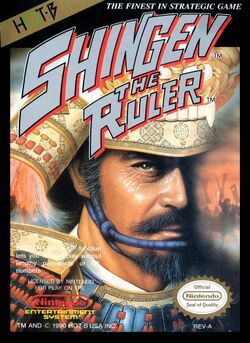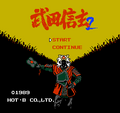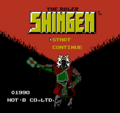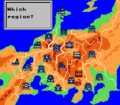
| Shingen the Ruler | |
|---|---|
| Developer(s) | Another |
| Publisher(s) | HOT-B |
| Year released | 1989 |
| System(s) | NES |
| Preceded by | Takeda Shingen |
| Genre(s) | Strategy |
|---|---|
| Modes | Single player |
Shingen the Ruler, known in Japan as Takeda Shingen 2 (武田信玄2?), is a turn-based strategy game developed by Another for the Famicom and NES, and published in Japan by HOT-B in 1989. It was released in North America in 1990. It is the sequel to the original Takeda Shingen game, which was never released in North America. The player must build up their forces, form alliances, and do battle with other warlords of the era.
The game is set during the Sengoku period of Japan. The player is Takeda Shingen, who is based in the holding of Kai and Shinano. The goal of the game is to conquer central Japan, roughly spanning from Kyoto to Kamakura. With the exception of "General Li" and "General Su" in the holding of Noto, the remaining warlords depicted in the game are actual historical figures, including Oda Nobunaga and Uesugi Kenshin. Play starts in January, 1545, and the player may make one action per province (up to 4) per month.
The player must build and train an army, cultivate provinces, make (and break) alliances with neighboring daimyo. The game featured both random disasters (such as floods) and predefined events (such as the death of Shingen's father). One could also train Shingen's heir, Takeda Katsuyori.
Combat consisted of a field skirmish, followed by a battle at the castle itself. Each holding's field and castle varied in layout. An automatic battle system was also provided, which calculated damage done by each army.
In an unusual move, the label on the NES cartridge features an index detailing what each of the abbreviations in the in-game menus stand for. The decision to place such information directly on the cartridge itself is noteworthy due to the fact that when the game was published in North America, the top-loading variant of the NES had yet to exist. At the time, there was no way to read the label while playing the game.
-
Japanese box art
-
Japanese title screen
-
Title screen
-
Game screen




